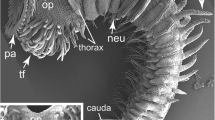Summary
Morphology and movement of the spines of Acanthaster planci were studied. All surfaces of the animal are covered with spines. The spines on the aboral surface are cylindrical with sharp tips. The spines on the oral surface are flat; they bend over to cover the mouth and the ambulacral grooves when these soft parts are stimulated. Those on the side of the animal make a barrier of crossed spines. Thus the structure and movement of the spines are well-adapted for defense.
The junction between the primary aboral spine and its pedicel makes a movable joint. The ultrastructure of the connective tissue at the joint was studied. The connective tissue is mainly composed of collagen fibers. Presumed neurosecretory cells with processes which are filled with electron-dense granules of 0.2 μm diameter were found between collagen fibers. Muscle fibers are mainly found in the connective tissue at the central holes. These observations support the view that the joint connective tissue has catch properties.
Similar content being viewed by others
References
Byrne M (1982) Functional morphology of a holothurian autotomy plane and its role in evisceration. In: Lawrence JM (ed) Echinoderms: Proceedings of the international conference, Tampa Bay. Balkema, Rotterdam, pp 65–68
Endean R (1973) Population explosions of Acanthaster planci and associated destruction of hermatypic corals in the Indo-West Pacific region. In: Jones OA, Endean R (eds) Biology and geology of coral reefs, Vol. 2. Academic Press, New York, pp 389–438
Halstead BW (1978) Poisonous and venomous marine animals of the world. Darwin Press, Princeton, pp 1043
Hashimoto Y (1977) Marine toxins. Japan Scientific Societies Press, Tokyo, pp 377
Hidaka M, Takahashi K (1983) Fine structure and mechanical properties of the catch apparatus of the sea-urchin spine, a collagenous connective tissue with muscle-like holding capacity. J Exp Biol 103:1–14
Holland ND, Grimmer JC (1981) Fine structure of syzygial articulations before and after arm autotomy in Florometra serratissima (Echinodermata: Crinoidea). Zoomorphology 98:169–183
Madsen FJ (1955) A note on the sea star genus Acanthaster. Vidensk Medd Dansk Naturhist Foren 117:179–192
Motokawa T (1982a) Rapid change in mechanical properties of echinoderm connective tissues caused by coelomic fluid. Comp Biochem Physiol 73C:223–229
Motokawa T (1982b) Fine structure of the dermis of the body wall of the sea cocumber, Stichopus chloronotus, a connective tissue which changes its mechanical properties. Galaxea 1:55–64
Motokawa T (1983) Mechanical properties and structure of the spine-joint central ligament of the sea urchin, Diadema setosum (Echinodermata, Echinoidea). J Zool (London) 201:223–235
Motokawa T (1984) Connective tissue catch in echinoderms. Biol Rev 59:255–270
Nishihira M, Yamazato K (1972) Brief survey of Acanthaster planci in Sesoko Island and its vicinity, Okinawa. Sesoko Mar Sci Lab Tech Rep 1:1–20
Potts DC (1981) Crown-of-thorns starfish-man-induced pest or natural phenomemon? In: Kitching RL, Jones RE (eds) The ecology of pest. Some Australian case histories. CSIRO, Melbourne, pp 55–86
Sakai K (1985) Brief observations on the population of Acanthaster planci (L.) and coral assemblages around Sesoko Island, Okinawa in 1983. Galaxea 4:23–31
Smith DS, Wainwright SA, Baker J, Cayer ML (1981) Structural features associated with movement and “catch” of sea-urchin spines. Tissue Cell 13:299–320
Taira E, Tanahara N, Funatsu M (1975) Studies on the toxin in the spines of starfish Acanthaster planci. I. Isolation and some properties of the toxin found in spines. Sci Bull Coll Agr Univ Ryukyus 22:203–213
Wilkie IC (1979) The juxtaligamental cells of Ophiocomina nigra (Abildgaard) (Echinodermata: Ophiuroidea) and their possible role in mechano-effector function of colleagenous tissue. Cell Tissue Res 197:515–530
Wilkie IC (1984) Variable tensility in echinoderm collagenous tissues: a review. Mar Behav Physiol 11:1–34
Wilkie IC, Emson RH, Mladenov PV (1984) Morphological and mechanical aspects of fission in Ophiocomella ophiactoides (Echinodermata, Ophiuroida). Zoomorphology 104:310–322
Author information
Authors and Affiliations
Rights and permissions
About this article
Cite this article
Motokawa, T. Morphology of spines and spine joint in the crown-of-thorns starfish Acanthaster planci (Echinodermata, Asteroida). Zoomorphology 106, 247–253 (1986). https://doi.org/10.1007/BF00312046
Received:
Issue Date:
DOI: https://doi.org/10.1007/BF00312046




